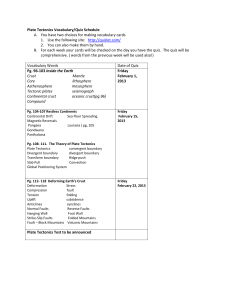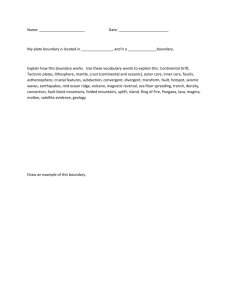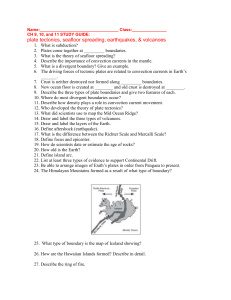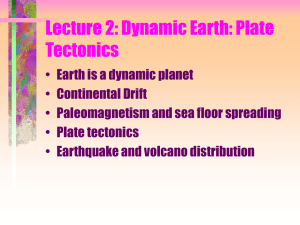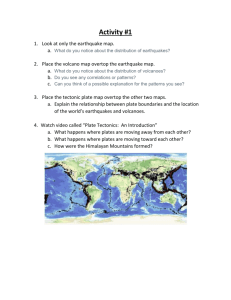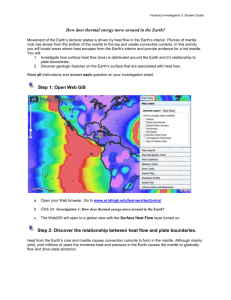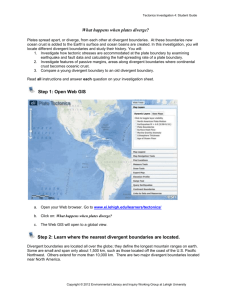File - KMS 8th Grade Science
advertisement
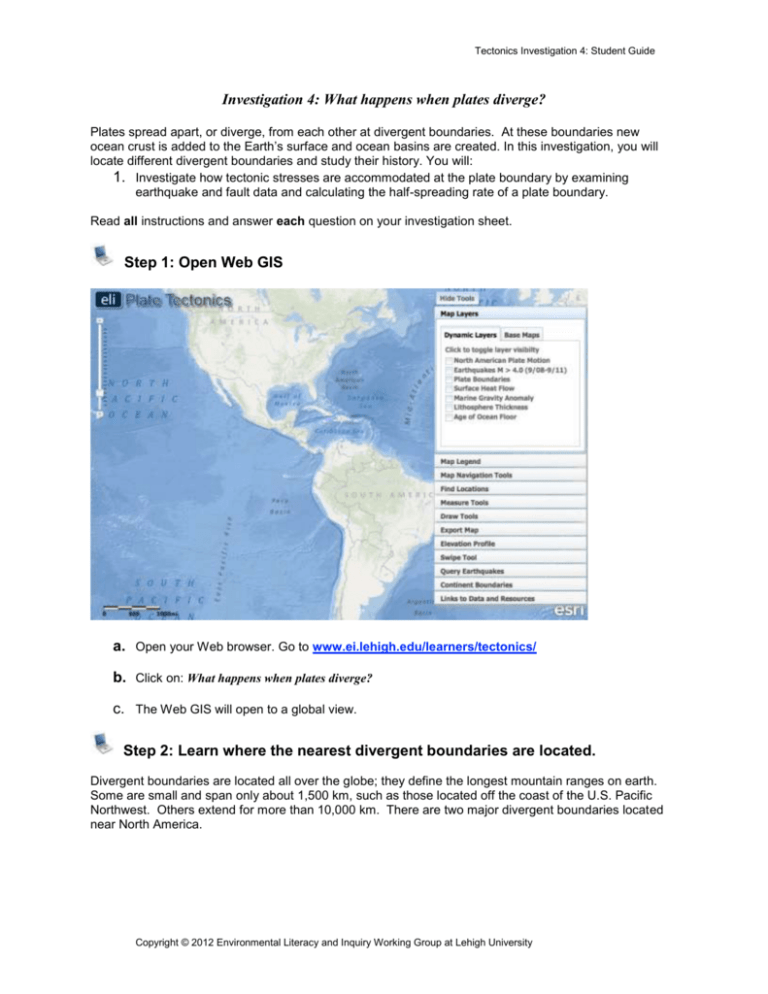
Tectonics Investigation 4: Student Guide Investigation 4: What happens when plates diverge? Plates spread apart, or diverge, from each other at divergent boundaries. At these boundaries new ocean crust is added to the Earth’s surface and ocean basins are created. In this investigation, you will locate different divergent boundaries and study their history. You will: 1. Investigate how tectonic stresses are accommodated at the plate boundary by examining earthquake and fault data and calculating the half-spreading rate of a plate boundary. Read all instructions and answer each question on your investigation sheet. Step 1: Open Web GIS a. Open your Web browser. Go to www.ei.lehigh.edu/learners/tectonics/ b. Click on: What happens when plates diverge? c. The Web GIS will open to a global view. Step 2: Learn where the nearest divergent boundaries are located. Divergent boundaries are located all over the globe; they define the longest mountain ranges on earth. Some are small and span only about 1,500 km, such as those located off the coast of the U.S. Pacific Northwest. Others extend for more than 10,000 km. There are two major divergent boundaries located near North America. Copyright © 2012 Environmental Literacy and Inquiry Working Group at Lehigh University Tectonics Investigation 4: Student Guide a. Click on the Map Layers tab in the toolbox menu. b. Turn on the Enhanced Bathymetry / Topography layer. c. Let’s find a divergent boundary in the Atlantic Ocean. To do this, locate latitude 31º and longitude 41º on the map. At this location, you will find the name of the feature that lets you know there is a divergent boundary. Answer Question #1 on your investigation sheet. d. Before moving on, look at the ocean bathymetry along this boundary. e. On the map, darker shades of blue represent lower elevations (deeper water) and lighter shades of blue represent higher elevations (shallower water). See if you can trace this feature to the north and south. a. Let’s find a divergent boundary in the Pacific Ocean. b. Use the navigation tools to locate and zoom to latitude -29º and longitude -112º. At this location, you will find the name of the feature that lets you know there is a divergent boundary. Answer Questions #2 and #3 on your investigation sheet. Step 3: Discover the relationship between earthquakes and divergent boundaries. 2 Tectonics Investigation 4: Student Guide Earthquakes along divergent boundaries result from movement on extensional faults also known as “normal faults”. These faults form because a force called “tension” pulls the rocks away from each other. a. Click on the Map Layers tab in the toolbox menu. b. Turn-off the Enhanced Bathymetry/Topography layer. Activate the Earthquakes M > 4.0 (9/08-9/11) and Plate Boundaries layers. c. Click on the Map Legend tab to interpret the data displayed on your map. a. Use the Query Earthquakes tab to investigate the locations of extensional (normal) faults. b. Click on the Query Earthquakes tab in the toolbox menu. c. Make sure the “All Depths” option is selected from the Select Earthquake Depth drop down menu (B). d. Make sure “extensional” from the Select Primary Fault Type drop down menu (A). e. Click to observe the plate boundary earthquakes that occurred on extensional faults. Answer Question #4 on your investigation sheet. 3 Tectonics Investigation 4: Student Guide a. Click on the Map Layers tab in the toolbox menu. b. Turn on the North American Plate Motion layer. Answer Question #5 on your investigation sheet. Then, turn off the North American Plate Motion layer. Step 4: Calculate divergent boundary spreading rates. At divergent boundaries, the sea floor spreads apart on both sides of the mid-ocean ridges, and magma wells up from the mantle to add new crust to fill the gap. As a result, the ocean floor moves like a conveyor belt, carrying the continents along with it. The spreading rate is the speed that the plate is moving away from the boundary. The half-spreading rate can be calculated by dividing the distance between the crust and the plate boundary by the age of the crust. The bordering continents are separating at twice the spreading rate. Half-Spreading Rate = Distance between crust and plate boundary ÷ Age of the crust (Time) a. Click on the Map Layers tab in the toolbox menu. b. Turn-off the Earthquakes M > 4.0 (9/08-9/11), Lithosphere Thickness, and Surface Heat Flow layers. Activate the Age of the Ocean Floor layer by clicking on the check box. c. To view the map legend, click the Map Legend tab in the toolbox menu. The color indicates the age of the ocean floor at a location. Scroll down with the scroll bar to view the entire legend to 280 m.y. (See image to the right.) Answer Questions #6-9 on your investigation sheet. 4 Tectonics Investigation 4: Student Guide a. To calculate the half-spreading rate of the North American plate at the divergent boundary in the Atlantic Ocean, you will divide the distance the plate has traveled by the time it took to travel that distance. Half-Spreading Rate = Distance ÷ Time b. Click on the Map Navigation Tools tab in the toolbox menu. Select MidAtlantic Ridge from the list of bookmark locations. c. Use the Distance measure tool to measure the distance of the oldest ocean floor from the divergent plate boundary. (i) Go to the Measure Tools tab. (ii) Click on the Distance measure tool. (iii) Click on a point on the MidAtlantic Ridge near latitude 30º and longitude -41º. (iv) Drag your mouse perpendicular to the oldest ocean floor near latitude 39º and longitude -72º. (v) Double click at the left edge of the oldest ocean floor to display the measurement result. (See image to the right.) Important note: Double-clicking on the distance measure will complete your measurement for your line. Click anywhere on the map to begin a new line with the distance measure tool. Your previous line will disappear. Record this distance on the chart in #10 on your investigation sheet. Be sure to include the measurement units. d. Click the Map Legend tab in the toolbox menu. Determine the age of the oldest ocean floor you measured to. Record this age of the ocean floor (from the step above) on the chart in #10 on your investigation sheet. Calculate the half-spreading rate (Distance ÷ Time) to complete your chart. Don’t forget units! 5 Tectonics Investigation 4: Student Guide a. Next, calculate the half-spreading rate of the Nazca Plate at the East Pacific Rise. You will divide the distance the plate has traveled by the time it took to travel that distance. b. Click on the Map Navigation Tools tab in the toolbox menu. Select East Pacific Rise from the list of bookmark locations. c. Use the Distance measure tool to measure the distance of the oldest ocean floor from the divergent plate boundary. (i) Go to the Measure Tools tab. (ii) Click on the Distance measure tool. (iii) Click on a point on the East Pacific Rise near latitude -20º and longitude -114º. (iv) Drag your mouse perpendicular to the oldest ocean floor near latitude 20º and longitude -71º off the west coast of South America. (v) Double click at the right edge of the oldest ocean floor to display the measurement result. Record this distance on the chart in #11 on your investigation sheet. Be sure to include the measurement units. d. Click the Map Legend tab in the toolbox menu. Determine the age of the oldest ocean floor you measured to. Record this age of the ocean floor (from the step above) on the chart in #11 on your investigation sheet. Calculate the half-spreading rate (Distance ÷ Time) to complete your chart. Don’t forget units! Then, answer Question #12 on your investigation sheet. 6


